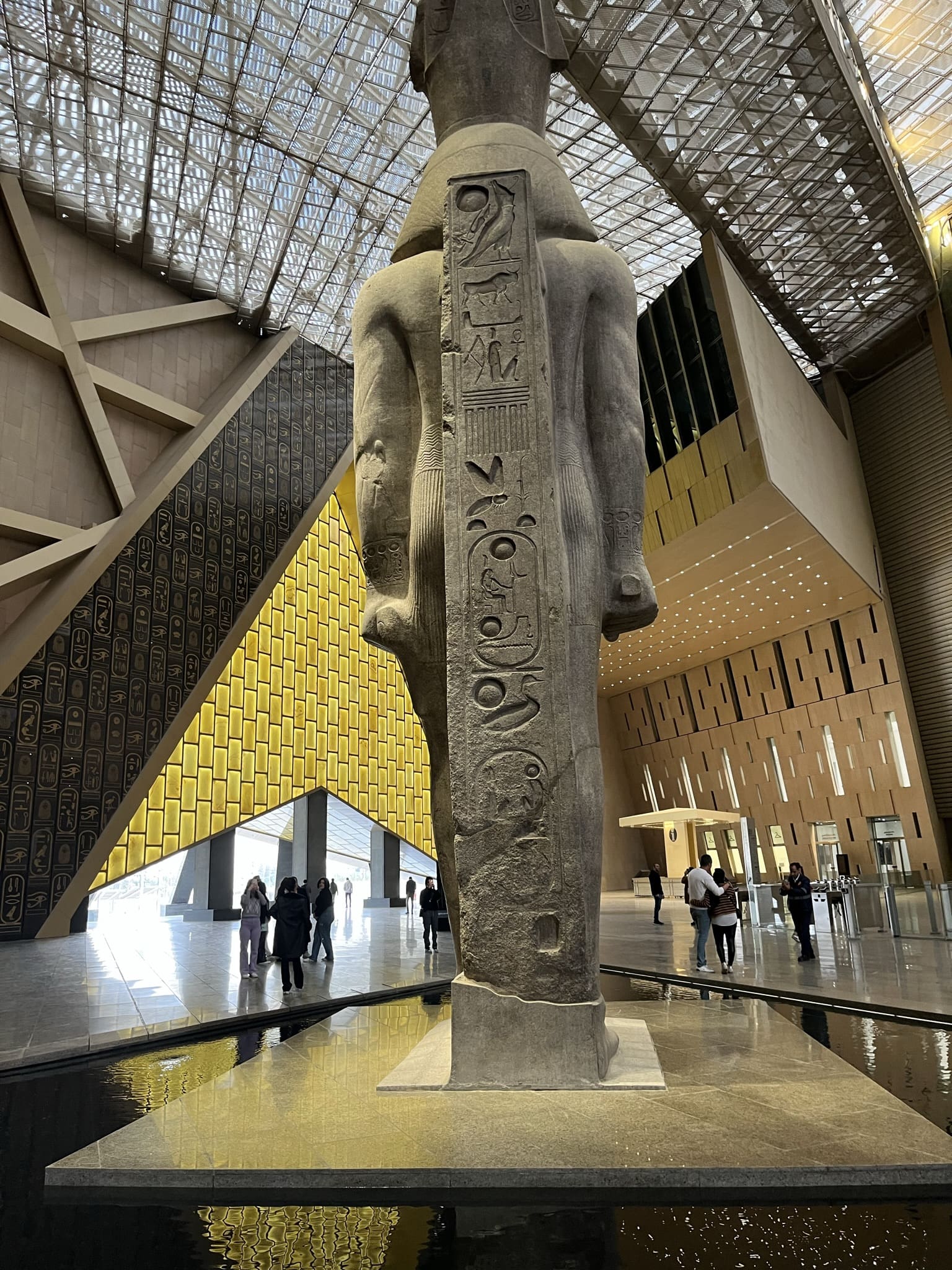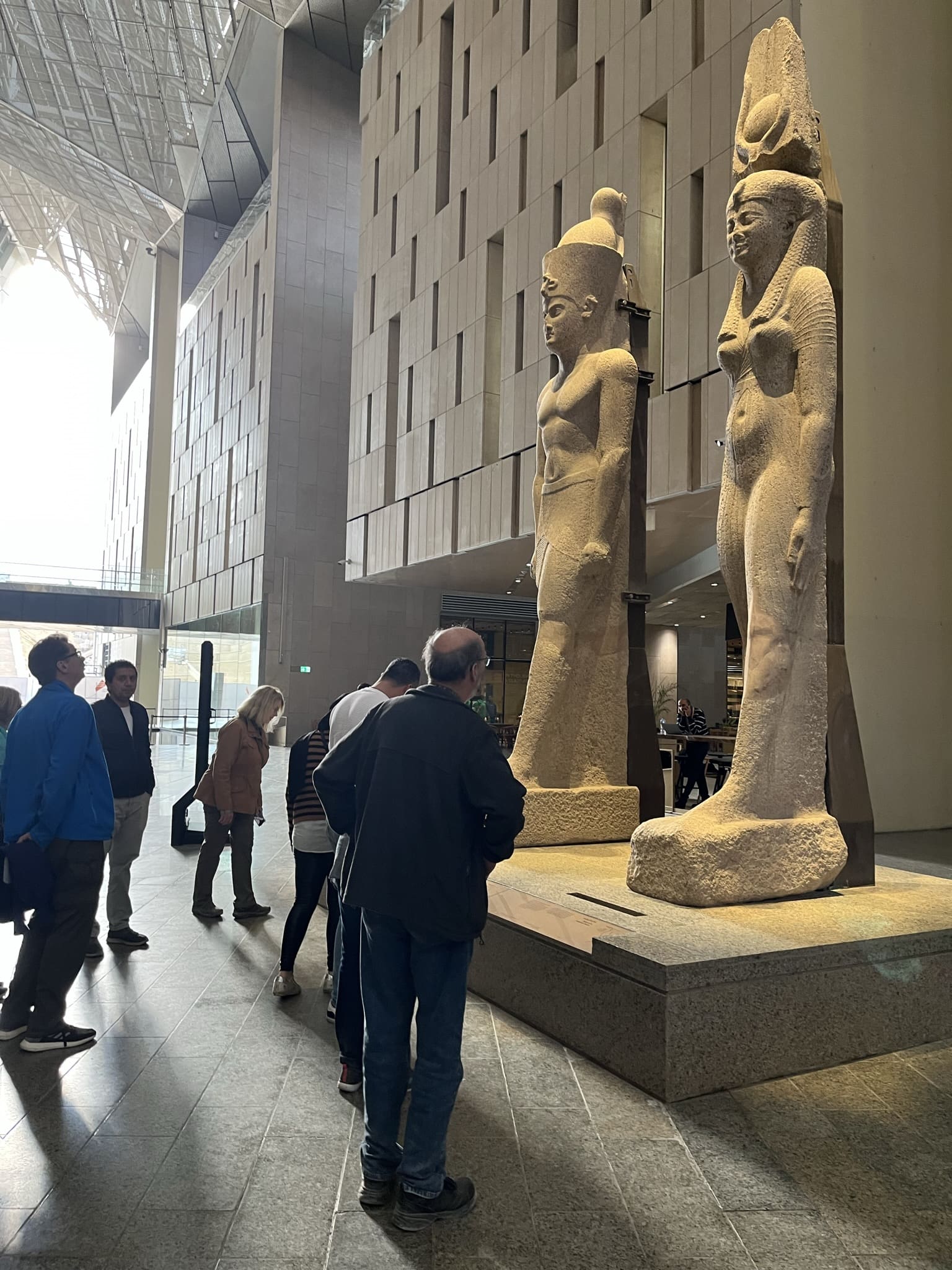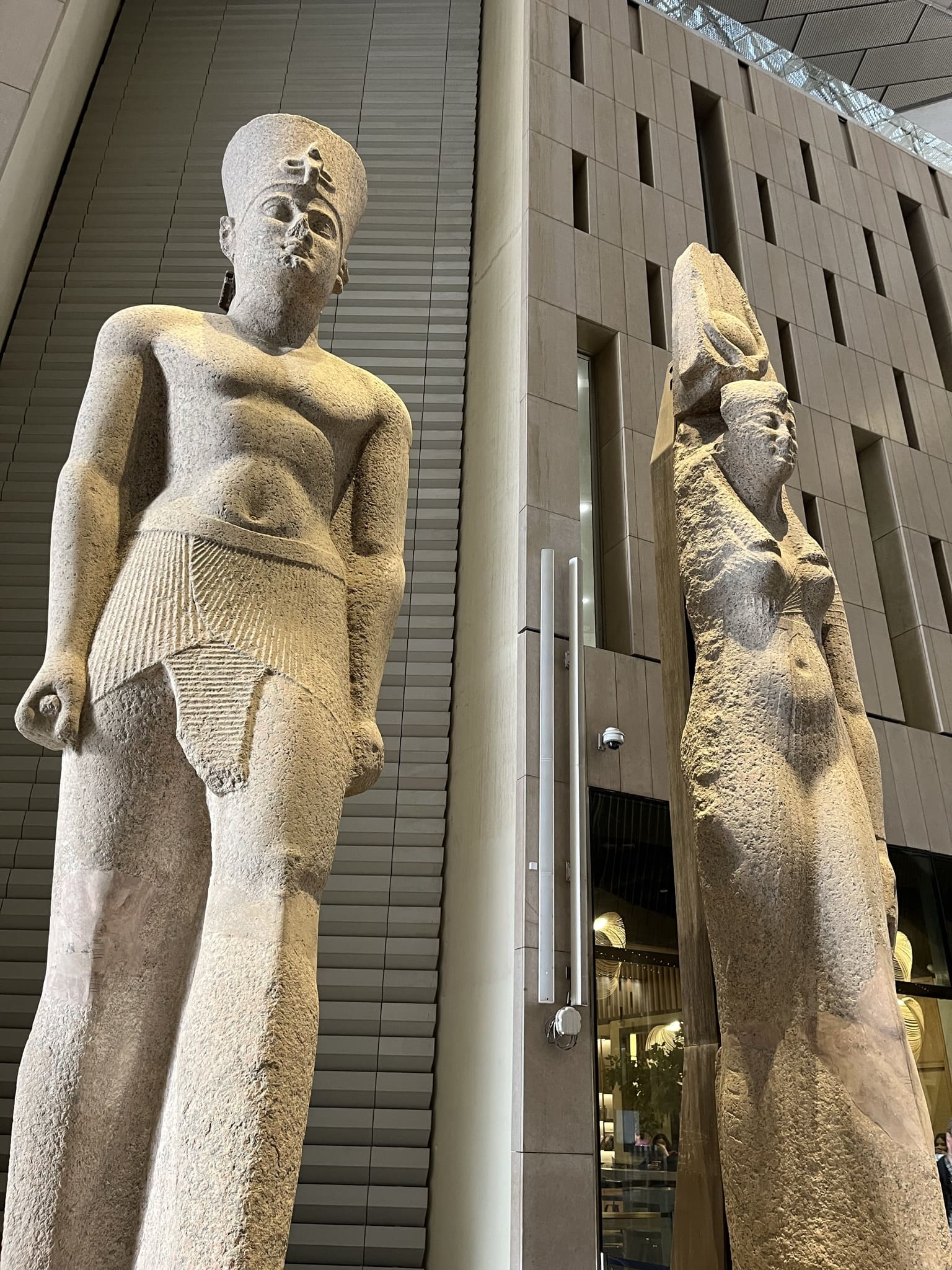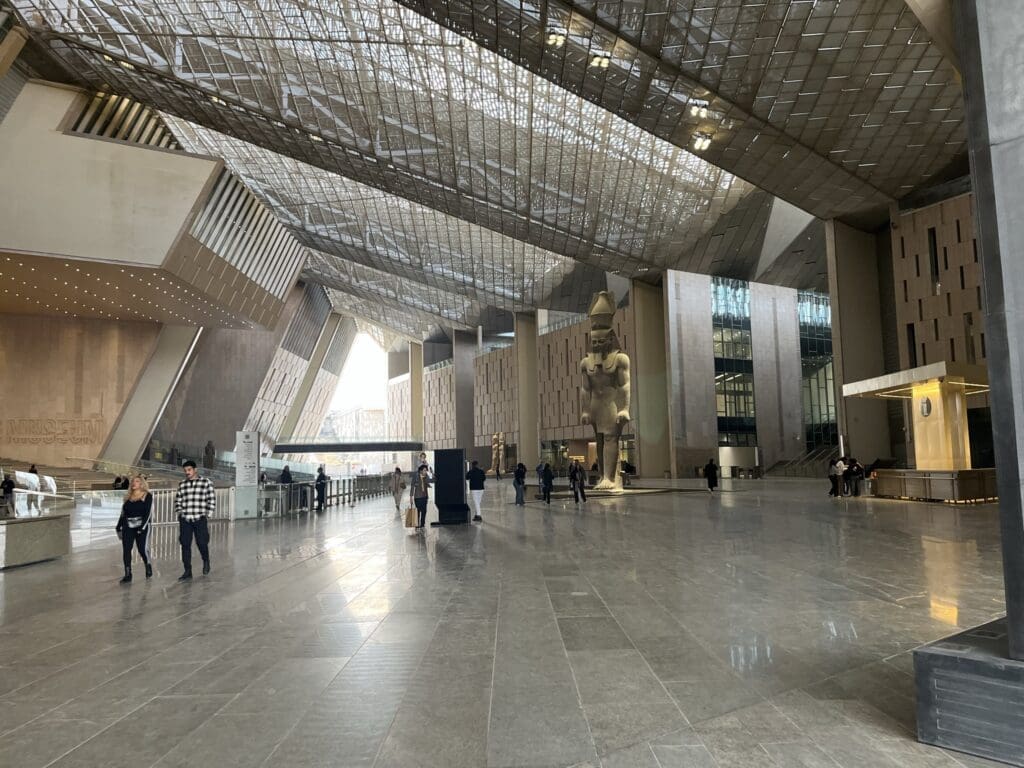
by Laura Ranieri Roy
Soaring, gleaming – elegantly modern and refined. A repository of the greatest archaeological treasures in the world. I am speaking of course about the Grand Egyptian Museum – the GEM — a wondrous edifice that now rises at the foot of the Giza pyramids – yet another great wonder of the world has appeared.
Our group was among the first lucky ones to enter its elegant courtyard and magnificent main hall in February 2023 as soon as a soft opening was finally announced. The full grand opening attended by kings, presidents, and dignitaries should unfold soon.

In this brief article, I will reveal what we encountered in words and images – and give you a little insight into the great masterpieces, the grand design – and other fabulous insights into the Egypt’s GEM.
“A museum for the 21st century” is how the director-general of the Grand Egyptian Museum described it. And from all we saw, it certainly is.
A little background history on the GEM
Egypt has certainly emerged from a decade or more long “intermediate period” – a time of chaos and division – into a strong New Kingdom today. Today, from the ashes of the Arab Spring arises new roads, infrastructures, hotels, beautifully restored buildings… and a profusion of new site openings and archaeological discoveries. Among the most awaited openings of all is the GEM – slated to be the world’s largest and most magnificent archaeology museum in the world! At 484,000 square feet of galleries (and 3800 acres), it is indeed a modern wonder which will ultimately house more than 100,000 artifacts. The opening has been hotly anticipated for 15 years!
More than 30 years ago, in fact (1992), the Egyptian government announced the launch of a project to establish the GEM. A decade later in 2002, an Iris design and architecture firm (Heneghan Peng Architects) beat out more than 1,500 other hopeful firms from 83 different countries to win the design bid. The launch date was 2012. However, the project encountered many delays, including the Arab Spring of January 2011.
This past February, its doors finally opened, partially that is, with access to the atrium and the main hallway only. The gift shop, coffee shop, and outstanding ZOOBA restaurant is also now accessible to tourists.
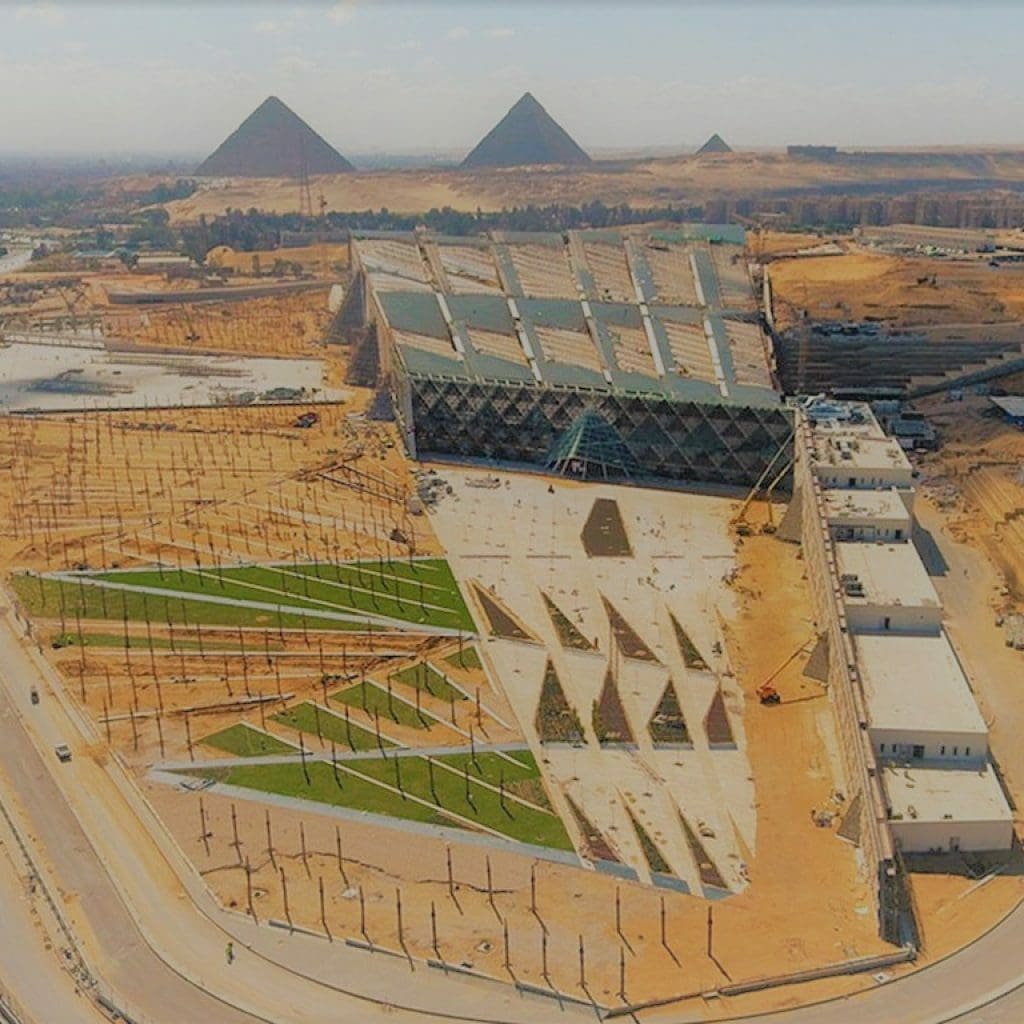
Aerial view of the Grand Egyptian Museum in Cairo. Photo courtesy Hill International
What is the experience like?
Sleek and sweeping views greet you as you enter the spacious, sunlit courtyard. The building itself is a symphony of light and shadow with a pyramid theme resonating everywhere you look.
The ancient Egyptians would have approved. MAAT (balance, truth, and harmony so dear to the culture) is brilliantly attained in every design aspect. It is a monumental edifice worthy of a Pharaoh and his divine gods. A true home for eternity.
There is a serenity and grandeur that envelops you in this open court. A pool of water shimmers in geometric splendour. Transcendent music soothes the soul.
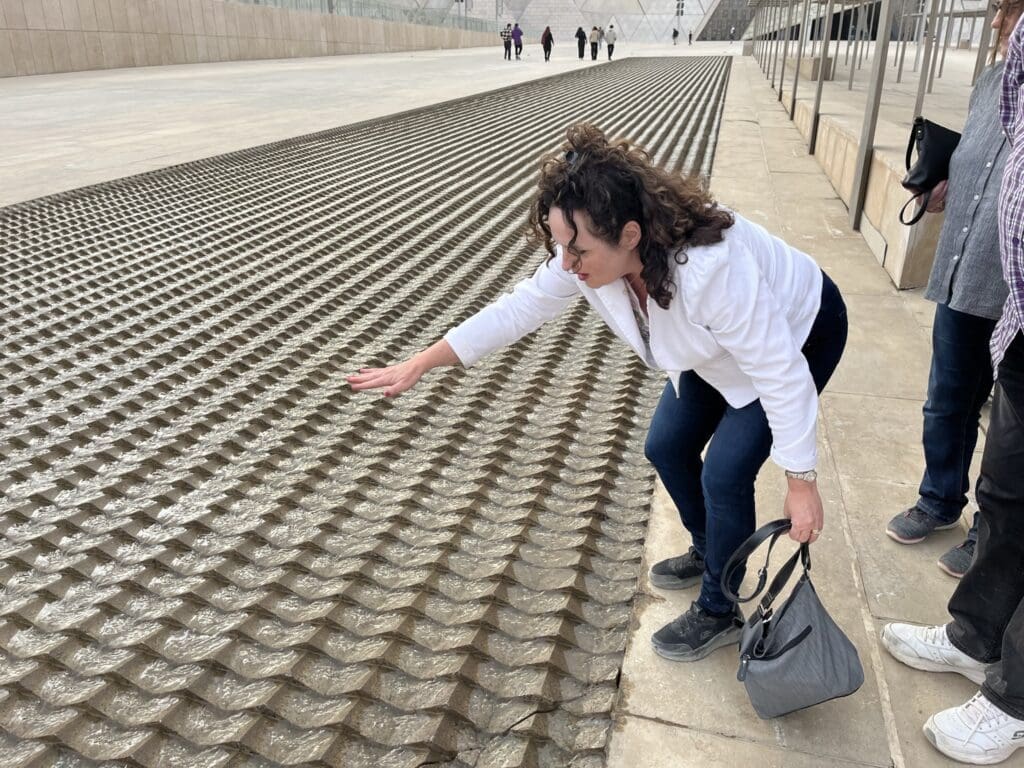
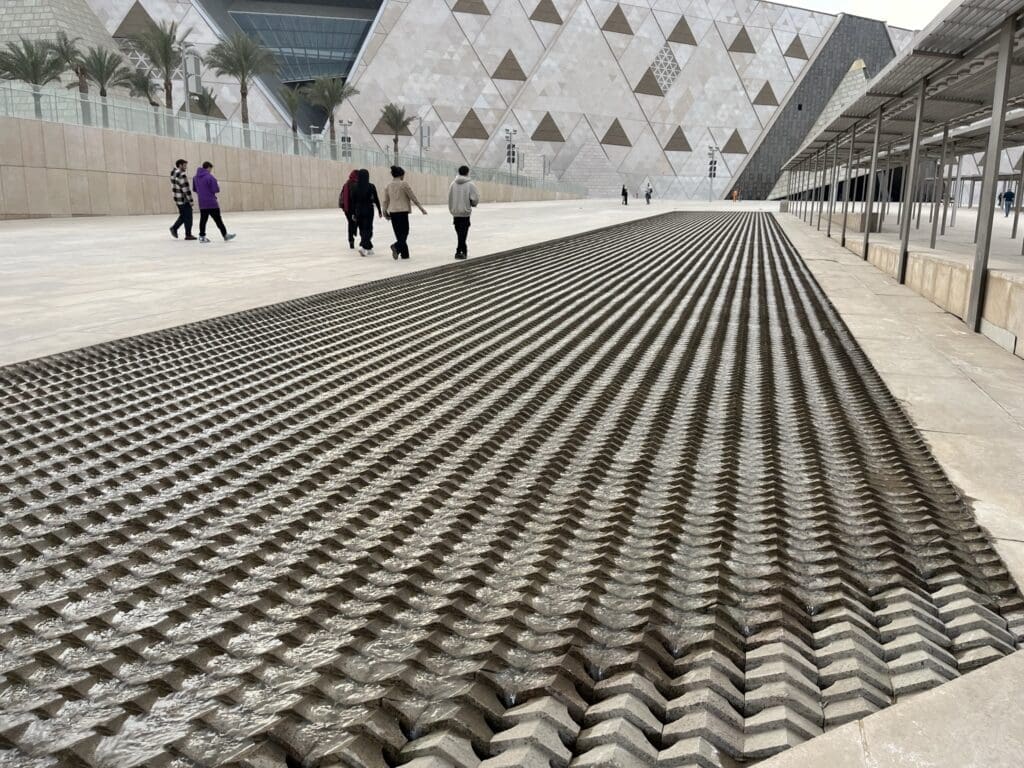
World’s First Hanging Obelisk
And there, like an other-worldly presence hovering in the air, is the world’s first hanging obelisk. Its unique, floating design gives the visitor a unique view of this ray of sunlight petrified in stone; as you stand on a glass plate under the monument, you can raise your eyes to behold the rare cartouche of Ramses II, there in the interior of the obelisk’s body, hidden from view for more than 3500 years!
The obelisk itself comes from Tanis, in the northeast Delta, Egypt’s capital for a brief time in the 21st and 22nd Dynasty during Libyan rule. Many of Ramses the Great’s monuments from the 19th Dynasty were brought here from his nearby city of Pi Ramses by these Libyan kings in the 8th and 9th century BCE.
Finally, on the pedestal of the obelisk is a beautiful welcome for visitors from across the globe: the word “Egypt” is tastefully engraved on the column coverings and sides of the obelisk base in all languages of the world!
Next your eye hits the museum’s exterior walls with that striking play of light and pyramidal form. On them are written the cartouches of the great kings, all displayed in their family groups, so that their “ren wr” (their great name) may be spoken… and thus their eternal life assured.
Inside the Great Hall: The Ramses Colossus
As you proceed into the museum’s atrium, the sense of space and grandeur is immense. The statue of Ramses II – a 36-foot-tall colossus weighing 80 tons– greets you – rising out of a pool of water like creation itself. This was the first artifact to come to the museum in 2018. The massive statue dating to the 13th century BCE was originally found broken in six pieces in ancient Memphis (Egypt’s old capital through the Old Kingdom much of its history). For 50 years, it stood at Cairo station, absorbing the fumes and pollution of the dense and heavily trafficked city. Now, cleaned and re-erected, it looms large in a place of honour. What’s more, just like Ramses’ divine shrine at Abu Simbel, architects have so positioned the statue so that the rays of the rising sun will light upon it on both the Winter and Spring Equinox (February 22 and October 22). What a spectacle that should be to behold
Victory Column of Merenptah:
Merenptah, the son number 13 of Ramses the Great (He outlived 12) was the fourth king of the nineteenth Dynasty (1213 BC – May 2, 1203 BCE). During his reign, he waged many great battles against the Libyans and Sea Peoples. This was famously also a time when the word Israel appears for the first time, as a tribe, not a country.
This great victory column in the atrium was rescued in 1970 from Matariya Cairo (ancient Heliopolis, the city of the sun). On this granite pillar, the Goddess Anath is recorded as saying “Take your mace that you may hit the rebels!” A fitting inscription to reflect the war torn nature of Merenptah’s times.
Sunken Statues of Ptolemaic King and Queen
The atrium is also home to two colossal statues found underwater in the Bay of Abu Qir, 6.5 km off the coast of Alexandria . Although no inscriptions remain on the two five-metre-high granite statues, they are likely images of King Ptolemy II Philadelphus (277-270 BC) and his Queen Arsinoe II dressed as the goddess Isis.
The two statues were discovered underwater in year 2000, by a joint mission of the European Institute of Underwater Archeology with the Egyptian Ministry of Tourism & Antiquities. The statues have been on a tour of exhibitions abroad in Europe and America since 2016.
10 Statues of Senwosret I
The theme of the grand foyer is “Kings and Deities” – and the great staircase just beyond the atrium features one of Egypt’s greatest kings. Senwosret I, the second king of the 12th Dynasty (1971 BC to 1926 BCE). This dynasty was notorious as a line of tough bureaucratic kings who sought to recentralize Egypt after the civil war and control the Nubians to the south with a string of great fortresses along the Nile. They ruled from Lisht and built pyramids and temples there. It is somewhat unsung era of Egyptian history.
The ten limestone statues of Senwosret I (painted to resemble granite) that adorn the staircase were found hidden in a cache in 1884 north of his mortuary temple at the capital Lisht. These are larger-than-life sitting statues of the king, some poised on block-like thrones and unfinished. They likely stood in his mortuary temple courtyard but were hidden in the cache to be saved from destruction at the beginning of the Hyksos period.
In a darkened room beyond the staircase we also glimpsed a great Sphinx of a Middle kingdom king – with serious frown — being prepared for display. Clearly, these lesser-known but equally important kings of this Middle Kingdom era will finally be given the spotlight they deserve at the GEM.
The Complete Collection of Tutankhamun – restored and together at last.
The museum will envelop the visitor through its artful, modernistic displays and take them on an inspiring march through 7,000 years of Egyptian history.
But at its core – its jewel in the crown — will be the entire Treasures of Tutankhamun collection, together in one museum for the first time and never to travel again. These priceless artifacts, from the massive gilded shrines and golden sandals to the funerary beds and chariots… all the way to the great golden mask… have been painstakingly conserved and restored in the GEM’s state of the art laboratories. The vision is this: you will not just see the treasures in displays, but walk through an entire experience of Tutankhamun’s life in which they play a meaningful part.
Upon publication of this article, the golden mask and a number of other iconic Tutankhamun treasures remain in the Egyptian Museum, Tahrir Square. This will change very soon. Tutankhamun’s sad, frail mummy, however, will likely remain in his tomb, KV 62 in the Valley of the Kings Luxor.
Of course, the new Zooba restaurant at the GEM is now open, serving up gourmet fare worthy of a Pharaoh. You can also do a little shopping in the beautiful high end gift store which includes everything from beautiful statuary, hand made textiles to Egyptian cosmetics, jewelry – and of course, books!
Perched at the foot of the plateau and accessible to the pyramids themselves via a fine 2-kilometre boulevard, the Grand Egyptian Museum is certainly poised to change Egypt and the touring experience. It will no doubt usher in a flood of museum-loving travelers who will pack the hotels and sites.
Come to Egypt with us… to see what all the excitement is about! And be dazzled!
<Learn more> about our 2024 small group expert-led tours to Egypt
All photos copyright Laura Ranieri Roy 2023 except for those otherwise credited.




